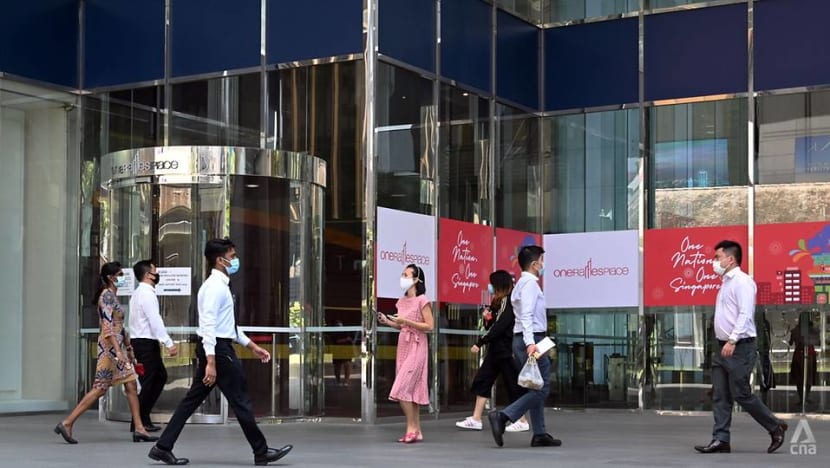Protecting and growing your retirement income
For those who have left the world of employment, the focus now shifts to growing and protecting their retirement income. Money Mind reports.

Office workers at Raffles Place on Jul 22, 2021. (File photo: Marcus Mark Ramos)
SINGAPORE: You've planned your retirement budget, put aside money for your nest egg, cleared out your office table and packed away your work wardrobe.
For those who have left the world of employment, the focus now shifts to protecting their retirement income.
As people progress through different stages of their lives, their investment requirements change. This means that they have to relook their investment priorities.
“I've come across many old people that take on young people’s risk. The truth is, you can’t, at that age. In your 50s, 60s and 70s, your ability to bounce back from catastrophic financial events falls tremendously,” said Mr Loo Cheng Chuan, founder of the 1M65 Movement, a CPF investment strategy to help Singapore couples become millionaires at retirement.
Singapore’s national annuity scheme, CPF Life, is the first layer of protection. It offers a monthly payout once members hit the eligibility age. The payout is continued no matter what age the CPF member lives to.
This, said Mr Vincent Chan of Fullerton Fund Management, makes it a good safety net given rising life expectancy.
“The average lifespan is about 85 years. The individual may live much longer than that. So having that life time annuity is extremely important because it gives the individual peace of mind that their money will not run out," said Mr Chan.
"The other part that comes along with this is the government guarantee. This is extremely important because many of the private sector solutions, even if they are annuities, are for a limited period, and are not guaranteed," he added.
There are three CPF Life plans: Basic, Standard and Escalating.
The Escalating Plan provides monthly payouts that increase by 2 per cent every year for life, and would suit those who are concerned about rising prices in the future.
The Standard Plan provides level monthly payouts, and the Basic Plan gives lower monthly payouts but leaves behind a larger legacy for loved ones.
CPF Life will take care of basic needs, but those looking for more than sustenance will have to secure additional income from other investments, said experts.
Those who invested in income funds in the run-up to retirement will be able to get a regular stream of income from those investments.
There are different types of income funds, including bond funds, asset allocation funds and equity funds that pay dividends.
Asset allocation funds invest across asset classes such as bonds, stocks and cash equivalents.
Market watchers caution that investors should be careful of high paying income funds that erode capital over time.
“When these funds promise over 6 per cent yields, they will need to dip into capital to make these income distributions. So, capital erosion would happen, and this is detrimental to investors because of cash drag that limits future capital gains," said Mr William Chow, director of manager research at financial services firm Morningstar.
"We find that 60 per cent of funds in Singapore that paid above, let's say 4 per cent regular yield, actually had lower net asset value (NAV) at the end of a five-year period of study.”
The NAV represents market value per unit of the fund. It is the price at which investors can buy or sell units of the fund. A lower NAV therefore indicates capital depreciation of the fund.
There are other red flags.
“We find that fixed income funds are also more prone to capital erosion, because of the lack of ability to capture the upside, relative to equity and allocation funds to compensate for the high payouts," said Mr Chow.
"We should highlight the very high frequency paying funds like monthly frequency, paying funds, these also typically have higher payouts than the quarterly or annual paying funds and capital erosion has been quite significant there.”
Another category of investments that give regular payouts are companies that have high dividends.
Market watchers warn that not all high dividend paying stocks are sound investments, though.
1M65 Movement’s Mr Loo said it is necessary to understand why some companies can pay high dividends.
“The reason why they pay high dividends, especially in the Singapore context is because they give out or pledge to give out a lot of their earnings, which means that they leave very little for their own growth and for their own research and development.
"When catastrophic market events like COVID-19 come along, these companies are hit very badly, and they have no buffer to fight this crisis, and they have not invested enough for the future for growth.”
Investors hence need to study the fund or stock carefully before putting in their money, especially if the funds are meant for retirement.
As retirees relook their equity exposure, they can also consider leaving a small proportion in high-risk equities, because of the upside potential.
"Your retirement time horizon is very long and stocks will be able to help you beat inflation, grow your capital so that you don't run out of money too early," said Mr Christopher Tan, CEO of Providend.
Even with income sources taken care of, good planning means being financially prudent.
"For the retiree the budgeting plan should consider what are your essential expenses that you must spend on, and what are the discretionary expenses that you can spend on if you have a bit more," said Mr Tan.
"A good spending plan should also have some form of reserves, so that if there are uncertainties, for whatever reason right, a market downturn, or there could be a family crisis that you need to help out with, at least you have reserves, to take care of the spending."


















